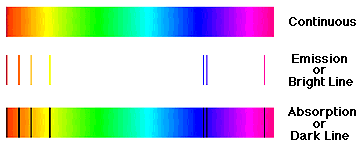Spectra and What Scientists Can Learn From Them
The word '
spectrum' (the
plural of which is 'spectra') comes from a Latin
word, spectare, which means 'to make a display out of something'. In
astronomy, the
thing we often make a display of is
radiation. In
particular, we spread out radiation into tiny increments of energy (or
wavelength) in
order to examine all of its pieces. On a "BIG" scale, we can think of
the electromagnetic
spectrum, which refers to all the different energies of radiation from the
very lowest energy radio
waves to the very highest energy
gamma-rays. But
since it is hard to examine the whole electromagnetic spectrum at once,
scientists often break it down into smaller regions for their studies. For
example, in the
X-ray
region, we might examine how much energy a source produces at every keV between
5 keV and 100 keV. The plot, or display, of this would be its X-ray
spectrum.
Have you ever seen a spectrum before? Probably so! Mother Nature makes
beautiful ones we call rainbows. She takes sunlight, sends it through
raindrops, and shows us the grand spectacle of the rainbow. She spreads out
sunlight to display its various colors (the different colors are just the way
our eyes perceive radiation with slightly different energies). A rainbow is
a spectrum. Aren't we lucky our eyes are made in a way that we can see
rainbows!

What Can Scientists Learn From a Spectrum?
It took a long time for scientists to learn how to use a spectrum to gain
insight into the universe.
Isaac Newton
(1642-1727) saw the spectrum from
sunlight as a continuous band of colors. In 1802, William Wollaston
(1766-1828) observed several dark lines in the spectrum of the Sun. He
thought they represented natural divisions between the colors. Joseph
von Fraunhofer (1787-1826) looked at sunlight with an even better prism. He
saw 600 such dark lines in the spectrum. Then finally, Gustav Kirchhoff
(1824-1887) figured out what was going on and gave the world a set of rules
describing what was making both the continuous spectrum that Newton saw and
the dark lines that Fraunhofer saw.
| Rule #1: |
A luminous solid or liquid emits a continuous spectrum of all
wavelengths. It has no lines in it.
|
| Rule #2: |
A rarefied luminous gas emits light whose spectrum shows bright
lines. These lines are called emission lines.
|
| Rule #3: |
If the light from a luminous source passes through a gas, the gas may
extract certain specific energies from the continuous spectrum. We then
see dark lines where the energy has been removed. These dark lines are
called absorption lines. |

Each element in the periodic table can appear in gaseous form and will
produce a series of bright lines unique to that element. Hydrogen will not
look like helium which will not look like carbon which will not look like
iron... and so on. Thus, astronomers can identify what kinds of stuff are in
stars from the
lines they find in the star's spectrum. This type of study is called
spectroscopy.
The science of spectroscopy is quite sophisticated. From
spectral lines
astronomers can determine not only the element, but the temperature and
density of that
element in the star. The spectral line also can tell us about any
magnetic
field of the star. The width of the line can tell us how fast the material
is moving. We can learn about
winds in stars
from this. If the lines shift back and forth we can learn that the star may be
orbiting another star. We can estimate the
mass and size of the
star from this. If the lines
grow and fade in strength we can learn about the physical changes in the star.
Spectral information can also tell us about material around stars. This
material may be falling onto the star from a doughnut-shaped disk around
the star called an
accretion
disk. These disks often form around a
neutron star or
black hole. The
light from the stuff between the stars allows astronomers to study the
interstellar medium
(ISM). This tells us what type of stuff fills the space between the
stars. Space is not empty! There is lots of gas and dust between the stars.
Spectroscopy is one of the fundamental tools which scientists use to study the
Universe.
|
